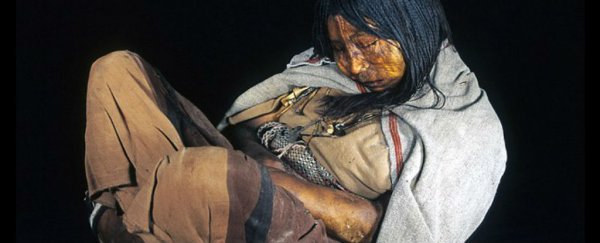Meet La Doncella ("The Maiden") - the mummified body of a 13-year-old Incan girl discovered in permafrost in 1999. Killed during a ritual sacrifice at Mount Llullaillaco in Argentina some 500 years ago, this girl is thought to be the descendant of the first people to settle the Americas 16,000 years ago.
Now a new study has analysed DNA from the Incan girl and 91 other individuals from the Pre-Columbian era to discover that their unique genetic line vanished once the Spaniards arrived during the 15th century.
"Surprisingly, none of the genetic lineages we found in almost 100 ancient humans were present, or showed evidence of descendants, in today's Indigenous populations," says lead researcher, Bastien Llamas from the University of Adelaide's Australian Centre for Ancient DNA (ACAD).
"This separation appears to have been established as early as 9,000 years ago and was completely unexpected, so we examined many demographic scenarios to try and explain the pattern."
LLamas and his team examined 92 skeletons and mummies, found mostly in the western part of South America, ranging from Mexico to Chile, and dated to between 8,600 to 500 years ago.
They sequenced each person's mitochondrial genome by extracting DNA from their bone and teeth. This type of genetic sequence is passed directly from a mother to her child, which means it can be used to trace the movements of a particular genetic lineage - in this case, halfway around the world.
Based on their analysis, the researchers identified 84 separate genetic lineages represented by the 92 samples. They suggest that the Incan girl's ancestors originated in Siberia, where they were isolated for around 2,400 to 9,000 years in what is now the Bering Land Bridge region.
They made their last contact with other Siberian populations around 23,000 years ago, before eventually colonising North America around 16,000 years ago.
From here, a portion of this small population broke off and made their way down the Pacific coastline, manoeuvring around massive ice sheets to colonise southern Chile around 14,600 years ago.
"It was at the peak of the last Ice Age, when cold deserts and ice sheets blocked human movement, and limited resources would have constrained population size," explains one of the team, Lars Fehren-Schmitz from the University of California at Santa Cruz. "This long isolation of a small group of people brewed the unique genetic diversity observed in the early Americans."
When the mitochondrial lineages from these 92 ancient people were compared to those of existing Indigenous Americans, they could not make a single match - La Doncella appears to have no living relatives.
"So it seems that there is a huge genetic diversity that was existing before the arrival of Europeans that just disappeared. It's extinct, we won't find it again," Llamas told ABC News. "We were expecting that some at least, of these past genetic lineages would have survived."
Publishing in Science Advances, the researchers suspect that the disappearance of these genomes is due to a number of factors, but suggest that these indigenous populations were so fragmented and isolated from each other for so long, they were quickly rendered extinct once the Europeans arrived with their deadly diseases, such as syphilis, smallpox, measles, mumps, and the bubonic plague.
Another option is that traces of them could still exist - we just haven't found them yet. The researchers acknowledge that present-day populations in South America haven't been sampled very well, but the fact that their results line up pretty convincingly with existing archaeological evidence and previous genomic studies means they're likely on the right track, Lizzie Wade reports for Science.
"The literature is full of examples where demographic models predicted using mitochondrial DNA were later corroborated by large-scale genomic analysis," Antonio Salas, a geneticist at the University of Santiago de Compostela in Spain, who was not involved in the study, told Wade.
The researchers will now be continuing their investigation into present populations to see if they can find some sign - however small - of the Incan girl and her people. If it turns out that we can conclusively say there are no traces left of these unique genetic linages today, we can at least start to figure out exactly what happened to them.
